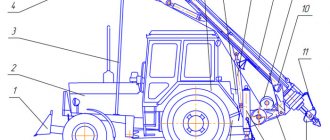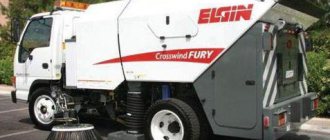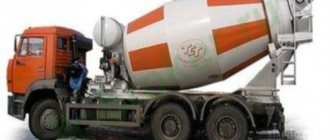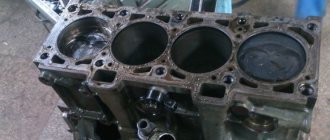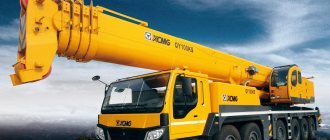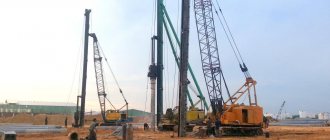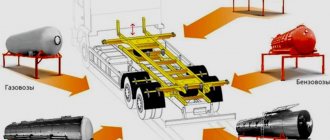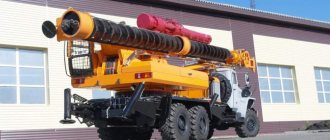Fixed drilling machine
This device has the following set of equipment:
- Transport base. This could be a truck or a tractor.
- Platform. A specialized frame for placing equipment mounted on a transport base.
- Drilling rig. It is equipped with a hydraulic mechanism for drill operation.
- Crane device. There are options where a drill and a crane are combined on one mast.
- Outriggers equipped with hydraulic jacks.
- Support stand.
- Electrical equipment.
- Mechanical transmission.
- Hydraulic system.
A more complex mechanism is the second version of the device. It should be considered for comparison.
Rotary drilling and crane machine
This device has a large number of mechanisms:
- Transport base. Typically a truck is used.
- The turntable is mounted on the chassis of the transport base and has a roller-turning mechanism.
- Pumping station.
- Support stand for the mast.
- Remote hydraulically controlled supports.
It should be noted that such a drilling machine has two bases: a transport and a rotary platform.
- Drilling and crane mechanism.
- Winch for hoisting operations.
- Hydraulic device for raising and lowering the mast.
- Mechanics for rotating the platform.
- The cabin in which the drilling machine operator will control the work.
- Well center indicator.
Rotary special equipment differs from the first option in increased productivity. This is achieved by drilling several holes from one position. It is also possible to quickly point the drill.
Drilling and crane machines and hole drills BKM on the basis of a tractor
Drilling and crane machines and tractor-based BKM hole drills often become the only option for special equipment available for construction, electrical installation and other work in suburban areas, rough and other difficult terrain. Drilling wells, loading and unloading operations, installing piles, supports and power line poles have to be carried out in places where the cross-country ability of wheeled all-terrain trucks is insufficient. Tractor-based drilling and crane machines mounted on a wheeled or tracked chassis are becoming a successful replacement for automobile cranes and hole drills. You can buy a tractor-based drilling and crane machine with optimal performance characteristics from our company. The catalog presents the most popular models, characterized by high maneuverability, reliability and good performance. Such special equipment is used to perform diverse local work that does not involve moving long distances. Drilling and crane machines and hole drills based on a tractor on a caterpillar chassis not only successfully overcome various obstacles, but also cope with complete off-road conditions. Tractor-based tracked BKUs have different performance characteristics, which determine the type and model of the chassis for mounting the BKU. The Hotomi BUER LS 2656-001 models and the TAURUS 086A drilling and crane machine based on the MCH-10 are equipped with a powerful drilling rig and a crane with a telescopic boom, the lifting height of which reaches 20 meters. At the same time, hole drills based on the MCH-10 skidder are capable of quickly drilling holes with a diameter of up to 100 cm to a depth of 5 meters , and working with loads whose weight reaches 7-7.5 tons . Equally popular among builders, electricians and other specialists are the lighter tracked models BM-531 and BM 534. Pit drills based on the TLT-100 or MTCH-4 tractor provide loading and unloading, moving cargo weighing up to 2 tons , and drilling wells for installing poles , supports, piles, fences and other structures to a depth of 5 meters . Representatives of BKM based on a wheeled tractor - special equipment from the MTZ line. The models are characterized by good maneuverability and are equipped with multi-purpose equipment, which includes a crane and a hydraulically driven drilling rig. Additionally, tractor-based drilling and crane machines can be equipped with a front-end hydraulic loader and a bulldozer blade. One of the tractor-based BKM models successfully used in various Russian regions is BM-205D. Among the advantages of the hole drill, owners highlight: small dimensions and optimal performance characteristics; good cross-country ability provided by 4 by 4 all-wheel drive, high maneuverability in narrow places; versatility of use - the ability to transport bulk cargo, drill holes for poles, piles, fences to a depth of up to 3 meters, lifting and lowering loads to a height of up to 7 meters; ease of operation and maintenance of the BKM; affordable price and low operating costs.
Equipment classifications
As we have already established earlier, self-propelled drilling machines can be rotary or fixed. In addition, there are a number of classifications:
- By type of transport base: machine and tractor. The former are characterized by high speed of movement of the installation, while the latter are characterized by all-terrain capability.
- Operating principle: cyclic and continuous drilling.
- By type of drive of the drilling and crane mechanism: mechanical, hydraulic, mixed.
- By type of mechanism for drilling and crane operations: combined (on one mast), separate (mast and boom separately).
- Location method: for non-rotating ones - lateral and rear, for rotating ones - on the rotating platform.
There are a significant number of types of classifications.
Main characteristics
The drilling machine has a number of basic technical characteristics. Based on them, equipment is selected for a particular activity:
- Drilling depth. For non-rotating machines this value ranges from two to three meters. For rotary ones - from 10 m to 15 m.
- Drilling angle. As a rule, it is in the range from 62 0 to 105 0.
- Well diameter. For non-rotating ones, the standard value ranges from 360 mm to 600 mm. For rotary ones – up to 630 mm.
- Load capacity ranges from 1.25 to 3 tons.
- The maximum length of the lifting load is up to 12 meters.
Depending on the technical specifications, the most suitable drilling machine is selected.
Main performance characteristics
After choosing the type of BKM, you need to evaluate the technical characteristics of the machine:
- Permissible drilling depth. Rotary machines are capable of preparing 10–15 meter wells, while for non-rotary machines the figure is limited to 2-3 meters.
- Possible change in drilling angle, which can be 62–105 degrees.
- Diameter of wells being constructed. For rotating machines it can reach 63 cm, for non-rotating machines it does not exceed 36–60 cm.
- Length of poles, supports that can be transported and installed. Some models of equipment have the ability to work with materials whose size reaches 12 m.
The carrying capacity of most types of this special equipment is 1-3 tons.
Operating principle of the drilling crane device
As a rule, this installation consists of the following parts: a mast, a rotation mechanism, a rod for replaceable drilling tools, hydraulics for feeding and retrieving the drill, hydraulic cylinders for raising to a vertical position and lowering to a horizontal position.
During transportation, the drilling and crane mechanism is in a horizontal position with emphasis on a special support stand mounted on the vehicle chassis. During operation, the mechanism maintains stability due to external hydraulic supports.
The rotation of the drill occurs due to conversion through the supply of translational-rotational energy from the motor of the transport base to the rotational mechanism of the drill.
On what principle does BKM work?
During transportation, the main mechanism is located and fixed on a special stand. To ensure stability during installation and drilling, hydraulic supports extend out on the sides of the machine.
The well construction is carried out due to the translational and rotational movement of the drill bit. The actuator drive is driven by the main engine of the vehicle. A support is installed into the prepared well using crane equipment. To ensure high-altitude work (laying power line wires), a lifting cradle is mounted on the boom, which can accommodate 1-2 people.
The use of drilling and crane machines increases the pace of work by 30–50%, without reducing the level of required safety.
Types of drills and working methods
There are several types of replacement parts:
- Lobed. They are devices with two double-threaded blades equipped with replaceable cutters. The kit also includes a spigot and dampers. The drill bit sets the direction of drilling and holds it relative to the axis of the process. The function of the shutters is to prevent soil from spilling out when removing the drill from the well.
- Screw. A spiral soil supply belt is attached to the frame. A drilling head with cutters and drill bits is attached to the end of it. When drilling wells, soil is fed in a spiral.
- Ring. In this device, the body is made in the form of a pipe, along the length of which there are screw blades. Cams with cutters and deflection bars are attached to the lower part. The drilling process occurs due to the destruction of the soil and the formation of a radius gap. Next, the soil is thrown through the deflecting slats to the outer slot of the wall and fed upward by the blades.
Drill bits are selected and installed depending on the soil and the required technology for performing the work.
Main advantages of the device
The drilling and crane machine (DCM) has become widespread due to its undeniable advantages:
- Mobility. She moves quickly around the construction site. If a rotary model is purchased, it is also possible to drill several wells from one stopping place due to the rotary platform.
- Three types of equipment on one platform. A drill, a crane for lifting loads and, if equipped with a cradle, the ability to perform high-altitude work. The time required to install and assemble a separate piece of equipment is reduced.
- Cost-effectiveness - by reducing the cost of purchasing three separate units of special equipment. Added to this are cost savings due to minimizing the number of service personnel. The driver controls the machine and does the work. Yes, such personnel must be trained and have appropriate clearances.
As you can see, for many areas of application these advantages will be decisive in the acquisition of such types of special equipment. Moreover, the equipment can be installed on both domestic and imported trucks.
Pros of BKM
The efficiency of using drilling and crane machines is determined by the following factors:
- High mobility, the ability to quickly move around work sites even in off-road conditions.
- The set of equipment allows you to perform all technological operations without the involvement of other equipment. With the additional configuration of the cradle, it is possible to carry out high-altitude work.
- Purchasing equipment of this class is cheaper than purchasing several machines, and operating costs are also reduced.
The use of such special machines allows us to reduce the number of personnel required for installation.
Areas of application
Most often, this special equipment is used in the construction industry.
In addition to civil engineering, the self-propelled drilling and crane machine is very popular in the construction of individual housing. Why? Again, thanks to the versatility of the equipment, and, accordingly, savings. Renting such special equipment will be cheaper than hiring two or three types of machines separately.
This type of special equipment is also popular in the construction of transmission lines and power supply. Due to its versatility and mobility, such equipment increases the speed of installing pole supports several times.
Another direction is the improvement and greening of the city. This includes painting at height, planting shrubs and trees, as well as pruning them. For landscaping, these types of devices have also found application in forestry areas. Only there are models with a transport base in the form of a tractor used. It is less mobile, but all-terrain.
Reviews
The well drilling machine, according to reviews, occupies a leading position in comparison with similar types of equipment. As numerous consumers say, the use of such special equipment increases the speed of construction of a pile-drill foundation several times. Also, this version of the technique has proven itself well in the construction of fences, where wells and the installation of poles are indispensable.
Professional organizations also note the convenience, cost-effectiveness and demand for this type of equipment.
DRILLING MACHINES
Drilling machines are used to form vertical, inclined or horizontal channels in the ground. With a diameter of up to 75 mm, these channels are called boreholes, more than 75 mm - boreholes. Drilling machines are used for geological exploration of soils, for drilling and blasting development of rocky and frozen soils, for dewatering, for the construction of communication and power line supports, and the like. The drilling process includes the destruction of soil and its removal from the well.
Soil drilling methods
The choice of drilling method depends on the soil, depth and diameter of the wells. There are mechanical, thermal and thermomechanical drilling methods. With the mechanical method, the soil is destroyed by a drilling tool; with the thermal method, it is destroyed by a high-temperature gas jet flowing at high speed from the burner; with the thermomechanical method, it is destroyed by the combined action of the gas jet and the drilling tool. In construction, mechanical drilling is a common method.
Depending on the kinematic conditions of the impact on the soil, machines are distinguished: rotary impact, rotary impact and rotary-mechanical drilling. They use electric, mechanical or pneumatic drives.
When rotary impact drilling of soil, the drilling tool is given rotational movements and shock impulses. Destruction products are removed by blowing with compressed air, washing with water or a clay solution.
During rotary impact drilling, the face surface is destroyed by a free-falling massive bit, while during the drilling process the bit is rotated at an angle of 20 - 40 °. Periodically, the well is filled with water, then the destruction products along with the water are removed with a bailer (a cylindrical vessel for lifting liquid, sand and drill mud from wells).
In rotary drilling, the development of the bottom hole and the removal of destruction products are carried out by rotating the drilling tool - drills. This method is common when drilling wells in frozen and thawed soils that do not contain large stones. Rotary drilling rigs are often manufactured in the form of drilling and crane machines, based on a car or tractor, equipped with mounted drilling and lifting equipment.
Design features of the main types of BKM
Depending on the tasks that require solutions, several types of drilling and crane machines can be used.
The non-rotating BKM is mounted on a car or tractor chassis, it is distinguished by the following design features:
- The main equipment is installed on a rigidly fixed platform frame.
- The package includes a drilling rig and a hydraulically driven crane. There are modifications in which these mechanisms are attached to a common mast.
- To ensure machine stability when performing work, the BKM is equipped with retractable supports with hydraulic jacks.
- The main systems that ensure the functioning of equipment include mechanical transmission, electrical equipment and hydraulics.
The rotary BKM has a similar configuration, but the equipment is placed on a platform that can rotate. This solution increases the versatility of the machine and ensures that work can be performed with a reduced number of maneuvers and moves.

